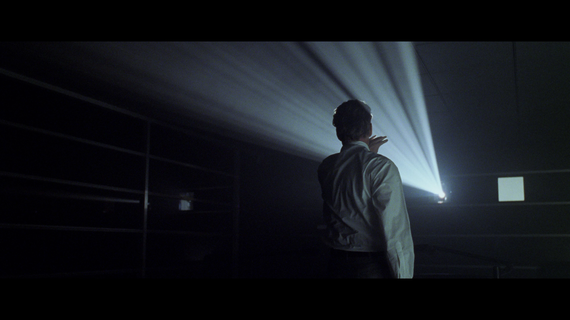
Daniel Schorr: (on TV) There's a tiny camera looking at you right now.
Nicholas van Orton: That's impossible.
Daniel Schorr: You're right, impossible. You're having a conversation with your television.
The Game (1997)
In David Fincher's 'The Game', Michael Douglas' bored-with-life banker Nicholas van Orton is either the centre of an insanely elaborate role play fantasy, or he's the mark in an equally byzantine con designed to liberate him of his fortune and potentially his life. While we're left guessing right to the end, what's clear is that Nicholas can't even sit down and watch TV without it talking back at him.
Beyond being a 129 minute slice of fine entertainment, I think the campaign architects among us can learn something from 'The Game' - something about how to design better advertising, where campaigns are more akin to episodic, multi-layered "real life" EXPERIENCES that place 'The Consumer' in circumstances not so dissimilar to those of Mr Nicholas van Orton.
But let me back up a bit and start with what we first understood by the term 'consumer-centric'. The late 90's new breed Comms Planners cried, "Put 'The Consumer' first!" It was a measured jab in the side of 'Account Planning', as born of the Stephen King/JWT School. Account Planning is too brand-centric declared the Comms Planners, meaning 'The Brand' shows too much ego and the manifestation is too likely a self-flattering 'TV ad', beamed intrusively into everyone's sitting rooms during those regulated bursts of interruption in between the actual TV shows we all tuned in to watch.
This, you appreciate, was all back in our analogue past when 'media channels' were few, little more than delivery mechanisms - figurative post men delivering the messages of the mad men - and when (in fairness) 'As seen on TV' still carried real cachet and clout.
But 'Comms Planning' (circa. 1998) gave credence to the notion that 'everything' communicates, every brand act, gesture and "touch point". There may be a media channel hierarchy, but everything from a bumper sticker to a TV centre break 'communicates' good or bad to a consumers overall, dot-joining, spider web perception of a brand.
But why the potted Adland history lesson? To steal a line from American author Bret Easton Ellis, because brand-building "is the game that turns as you play".
All that shake-up-the-system talk of becoming more 'Consumer Centric' now feels very 'Consumer Centric 1.0'.
While the notion of an end game campaign that was 'channel agnostic' and built on audience insight still makes cast-iron sense, it drops to its knees like a fallen warrior when the outcome remains a set of creative assets exhibited across a range of static media channels - the message still 'pushed' and media's only charge that of 'reaching eyeballs'.
And yet perhaps this was the fated inevitability of a noble sentiment in an analogue world, where people were talking 'Consumer Centric' BEFORE the world became a digital one?
Now we're ANNO DIGITAL, meaning 'Consumer Centric 2.0' is a very different box of delights with a very different set of implications.
Consider how 'technology' has changed the nature of media; how it's made and will continue to make "media" consumer-centric and evermore social. Think: Social TV (EPG meets Facebook), and Social Outdoor (digital posters as Twitter feeds).
At a $4bn valuation, Spotify has shown music's worth in our digital age. I'd argue Spotify's success-formula is born of putting its listeners in the centre of its digital system, in allowing the creating and sharing of playlists.
Is Spotify a tech, a kind of App, a product, a piece of media, a brand, or a consumer-centric blend of all the above? From Nike + to cycling apps like Strava, technology is allowing us to 'game-ify' our lives. Our pavements, cycle lanes and roads are being 'augmented', being re-imagined as bio and chrono-metric 'performance route maps' that allow us to turn every A-to-B into a kind of personal hero's journey.
Next generation "press formats" are emerging where 'The Magazine' becomes a live-feed blend of editorial comment and reader response. Where magazines once claimed to know their audience and write for them, tomorrow's magazines will see their readers contributing increasingly more than just a letter to a 'Readers Page'. "Culture" and "Media" has never been more symbiotic and co-authored.
Technology is reshaping culture. We've not only all become technophiles, but we've all become tech-empowered. In an age where we've all now become so accustomed to having a "voice", so accustomed to liking and tweeting and blogging and sharing, "brand-centric" campaigns are being humbled... but brand builders can slipstream the examples and fast apply the proof of concept.
'Consumer Centric 2.0' is all about 'The Consumer' being the very human and beating heart of a brand campaign, where we each feel like we're being given centre stage, role and deed.
Because who wants to feel inert, a mere aggregate-adding member of the couch-bound majority? Who wants to be viewed as passively receiving the contents of a flickering screen, that chewing gum for the eyes that asks little of the mind?
Alternatively, who wants to feel like Tom Cruise or Julia Roberts or Michael Douglas? Who wants to be the hero or heroine of the piece, in the middle of it all, senses alive? It's flattering to feel like the main attraction, being the one getting to roll the dice, with every suspicion that the entire game might be designed just for us.
Where 'The TV ad' was once a brand's main event, it's now more akin to a movie trailer - the buzz-bomb prior to the feature-length 'campaign'. And today's main campaign event, the "big feature-length presentation" is NOT all about consumers watching the brand equivalent of Tom Cruise or Michael Douglas. In our binary world, the TV ad sets the tone and possible theme, and then The Campaign puts the audience front and centre. It casts 'The Consumer' as hero and main protagonist. The consumer is no longer just the human insight trigger-pull to the subsequent brand campaigns we create.
21st century ad campaigns can crash first-person story-telling into digital media. A brand becomes the calling card, that knock at our door, a call to arms and action.
By extension of putting consumers "in control", the new consideration should become how campaigns can put them "in character". Beyond us asking, "What is the role for The Brand?", we need to establish, "What is the heroic role we are giving The Consumer? A hero-in-waiting needs to be called upon to do more than just "watch telly". Unlike Nicholas van Orton, we can't yet have a conversation with our TV sets, but in building brands, we are playing a very new game.
SP.
